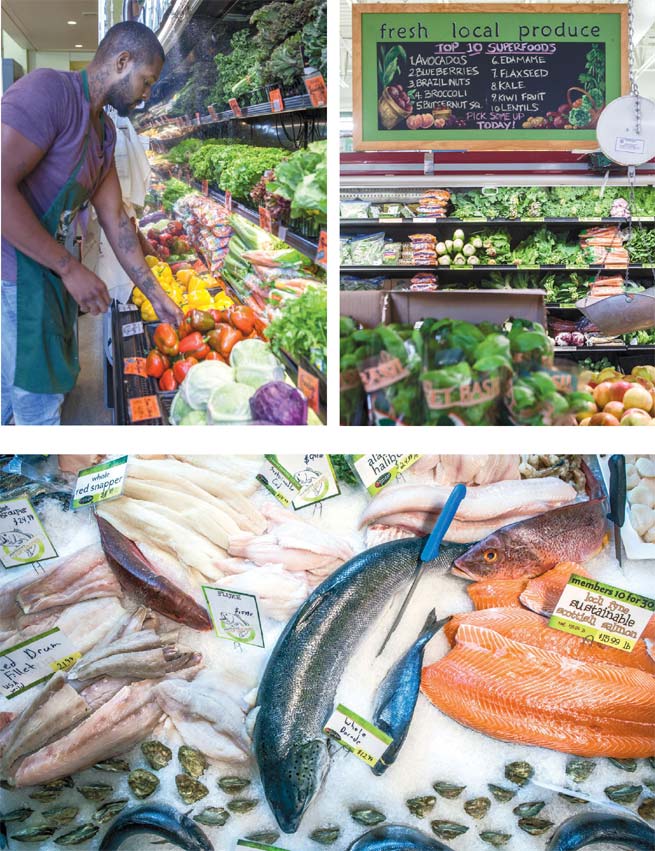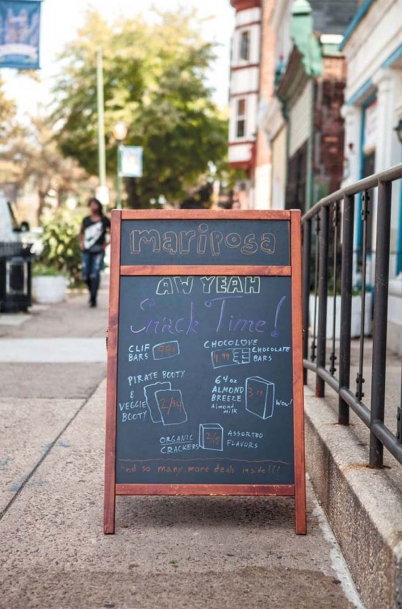Food Co-Ops 101
When it comes to food, the old often becomes new again. Grains from biblical times (like quinoa) are showing up in both temples of haute cuisine and the dinner tables of nutrition-minded home cooks.
Once the domain of depression-era grannies, canning is now a hipster hobby. And food cooperatives, once the property of peacesign flashing flower children, are opening at a rapid clip wherever conscientious shoppers seek apples and activism under one roof.
Co-ops are member-owned grocery stores that put every aspect of running the business into the recycled bags of invested shoppers. They are different from farmers’ markets and community-supported agriculture (CSA) programs, but there is a shared DNA. The coop’s shelves are probably stocked with the same onions and squash you’d spot at Headhouse Square Farmer’s Market, and the organic, pastured and grass-fed meat you purchase from regional buying clubs like Winter Harvest and Philly CowShare. But co-ops also stock household staples, like toilet paper and toothpaste, and other food products from sellers that meet member standards, like GMO-free snacks and fair-trade coffee. Co-op members join for the convenience of this one-stop shopping, but also because they trust that the inventory of the store reflects their values.
The Philadelphia area is home to some of the country’s oldest— and newest—food cooperatives. Since 1937, Delaware County’s Swarthmore Co-op has been a community center and reliable provider of quality local food. West Philly’s Mariposa Co-op and Mt. Airy’s Weavers Way Co-op (which boasts three stores and two farms) have grown since the early 1970s into Philly food institutions. All three of these veterans have undergone major expansions in recent years as they have evolved alongside the growing interest in alternative food sources.
Meanwhile, newer cooperatives, including the Doylestown Food Coop, founded in 2009, and the CreekSide Co-op in Elkins Park, started in 2007, are settling into their spaces. Soon-to-open cooperatives like those in South Philly, Kensington, Manayunk-Roxborough and Ambler are still rallying membership drives, raising money, carrying out market studies and choosing real estate for their future homes. While some co-ops, both start-ups and long-term operations, follow a buyers’ club model whereby members operate out of a site that serves as a hub for food deliveries and pickups on a weekly or biweekly basis, many evolve into storefront locations that are open daily.
ACTIVISM IN AISLE 5
To the uninitiated, cooperatives can seem like idealistic operations without ambitions beyond a folding table and an apple crate with a few hundred dollars worth of produce from a neighboring farm. But a co-op is no lemonade stand; it’s a 200-year-old business model that’s at the center of the collaborative economics movement, which aims to shift power to people from corporations. There are over 30,000 U.S. cooperatives. The businesses that operate this way include credit unions, energy companies and the outdoor adventure retailer REI. People who like the idea of putting their money into organizations that distribute wealth within their own communities are especially keen on cooperatives of all kinds.
The cooperative grocery store motto is simple: Food for people, not for profit. The objective has always been to get good food to members at a price that was fair for both the consumers and producers. It’s an impressive feat, considering the cooperative model often relies heavily on volunteers. Teams of strangers who convene with shared purpose are tasked with doing the hard work of recruiting members before a store ever exists.
Those who buy in during a cooperative’s infancy, before there is an actual place to shop, do it because they believe in the power of a hub owned by neighbors that exists for the betterment of the community. Regan Cooper has lived in South Philadelphia for seven years and joined the South Philly Food Co-op, storefront site unseen. “We pay into the corporate industrial food system involuntarily with our tax dollars,” says Cooper. “This co-op is a chance to put my money into the type of food system I actually want.” For many like-minded members, it always goes back to valuing people over profits.

MEMBERSHIP HAS ITS PRIVILEGES
In the most typical model, members buy equity in cooperatives in the form of a one-time fee of a couple hundred dollars that often secures membership for life. In return, members get a say in what items stock shelves, discounts in the store and with neighboring business partners. They also weigh in on where the store’s profits will be spent. Many co-ops also offer members dividends, which could be cuts of profits or reinvestment opportunities such as neighborhood revitalization programming, educational partnerships, store improvements or members-only pricing on special items.
“Member-owners are just that: owners,” says Alison Fritz, president of the board of directors for the South Philly Food Co-op. She is immersed in recruitment and site planning with a goal of opening storefront doors sometime next year. “Their $200 investment is not a donation or a membership fee. It’s an equity stake that gives everyone equal shares in the store.”
For Regan Cooper, $200 is a small price to pay for a hand in designing a community store that she’ll be proud to frequent and that also fuels the local economy. “I want to do what I can to reverse the trend of our food system,” she says. “I have to step up to make it a reality.” Gina and Jill Fenton joined the Swarthmore Co-op shortly after they moved from the Fairmount section of Philadelphia in 2012.
“We felt it was important to support the co-op because we believe in its mission of providing high-quality local and sustainable products,” says Gina. She recognizes the co-op as a community hub, explaining that neighbors come to shop the store and then go out from there to other businesses and neighborhood events nearby.
Food cooperatives are an optimal blend of farmers’ markets and one-stop-shop supermarkets, providing customers access to local food seven days a week. Marc Brown Gold, general manager of the Swarthmore Co-op, agrees with the Fentons’ perspective: “Joining a co-op is a vote for small producers, organic and sustainable growers, farmers who take into account the welfare of the animals they raise and the workers they hire.”
THE PRICE IS RIGHT
Co-ops are often unfairly compared to typical chain supermarkets whose size gives them the kind of buying power that drives low prices. When price is a shopper’s main criteria, co-ops can come up short, looking like a bad deal. But offering real value, not just in terms of price but in ethical terms, too, is a top priority for coop staff. “We’re working very hard to be careful about where your food comes from,” says Brown Gold. “We want members to trust that we’re putting products with integrity on the shelves.” The “Swarthmore Co-op Certified” endorsement assures members that they can trust store selections.
Members there also benefit from the “Back to Basics” program, which keeps costs of staple products like flour, pasta, peanut butter, toilet paper and chicken at very competitive prices. With Back to Basics, a dozen eggs from Lancaster County sells for $1.39 while regular Grade A eggs can cost nearly twice that price at a large chain grocer. The co-op’s “10 for 30” sale features select products at discounted prices each month. Cabot Cheddar, for example, is $8.99 per pound in the 10 for 30 sales, which matches the price for the same cheese in the SuperFresh sale circular. Switching to a co-op won’t cause a spike in grocery bills if shoppers can be careful about what is going into their carts.
At the Mariposa Co-op on Baltimore Avenue in West Philadelphia, members access good food at fair prices because the staff works directly with producers and suppliers, eliminating the need for a distributor and keeping costs down. “We really prioritize relationships with farmers,” says Bull Gervasi, facilities and produce manager. The timeintensive rapport-building he’s done with close to 100 farmers is just not an option for most grocery chains.
Mariposa is also part of a nationwide alliance of over 100 food cooperatives called the National Cooperative Grocers Association (NCGA). Together the group achieves the buying power of chain supermarkets, with volume orders that allow them to negotiate lower prices. “We saw price decreases on over 900 items through NCGA. We’ve done much better as a part of the group than we can do on our own,” says Gervasi.
CONNECTING CO-OPS AND COMMUNITIES
A core principle of all cooperatives is cooperation between cooperatives. Peter Frank, vice president of the board of directors for Kensington Community Food Co-op (KCFC), is working to establish the Philadelphia Area Cooperative Alliance (PACA), a group whose aim, in part, is to create joint purchasing with other co-ops for lower prices and more selection.
PACA’s purpose, though, isn’t exclusive to food cooperatives. The group will connect different types of cooperatives to one another. KCFC, for example, might introduce its members, who are already aligned with the broader cooperative philosophy, to the Energy Co-op, which supplies electricity, heating oil and biodiesel to Philadelphians as an alternative to mainstream energy services providers. “We’ll serve the greater Philadelphia area by growing the cooperative movement,” says Frank. Growth of the cooperative movement is good for the collaborative economics movement as a whole. It can lead to expansion and progress, like Weavers Way Co-op experienced in 2007 when it started a nonprofit with money earned through the co-op. Today, Weavers Way Community Programs (WWCP) works to increase access to healthy food through urban farm education, nutrition education in area schools, and the WWCP gardens at W. B. Saul Agricultural High School and Stenton Family Manor, an emergency housing facility for homeless families in Northwest Philadelphia.
Shortly after becoming a Weavers Way member in 2009, Margaret Guthrie started volunteering every week at the Stenton Family Manor garden funded by WWCP. There can be as many as 100 children living in the temporary housing that Stenton provides homeless families, and they are welcome to work in, learn and eat from the garden alongside Guthrie and other Weavers Way member volunteers.
“I love seeing the kids engaged in an activity that’s good for them and that they are enjoying,” says Guthrie. “It gives you a sense that you are actually making a difference.” Guthrie was recently elected to the board of WWCP where she works to continue outreach and uphold the cooperative principle: concern for community. “What are we about if we’re not about being good neighbors?”
Food cooperative storefronts across the Philadelphia area are open to the public—you don’t need to be a member to be a shopper. But most people who have committed to their stores as members never looked back. Bull Gervasi, of Mariposa Co-op, urges anyone concerned about food issues to consider joining a co-op near them. “If you care about local foods or investing in your neighborhood, a food co-op is the perfect fit,” he says.





